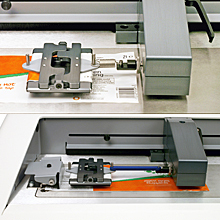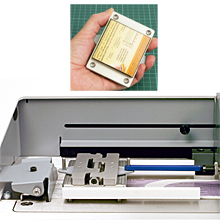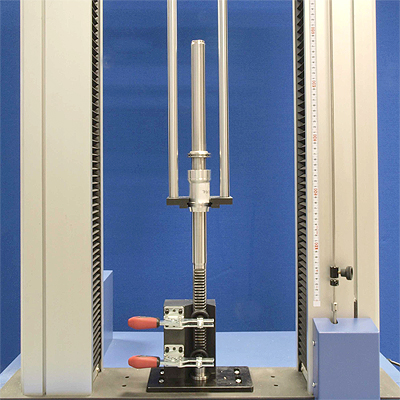
Mass production of goods often involves the transfer of items through the machines and transport mechanisms of the manufacturing process. Efficiency can be lost if the items misfeed or otherwise fail to move smoothly between operations. Consumer packaging used in the packing and shipping of products is affected by the frictional properties between the packaging material itself and the surfaces upon which it needs to slide. A specialist test solution to accurately measure the forces required to overcome the static and kinetic friction between the two surfaces enables the production organisation to evaluate different materials. Furthermore, this information then affords optimisation of machinery settings. A computer-controlled solution would involve a flat table upon which to locate the material sample, across which a block (‘sled’) of known mass is pulled by the test program. The force needed to initiate the movement is a function of the static friction (‘stiction’), the calculation of the average force to then maintain movement indicates the kinetic friction. The graphical output can also give an indication of the material’s propensity to cause judder or other undesirable characteristics.
Mecmesin Systems: Computer-controlled force test system, test hook
Case Study: Coefficient of Friction Test

The static and kinetic dry friction properties of contacting surfaces is extremely significant in the labelling, packaging, print and warehousing/shipping/moving industries. Surfaces which move over each other easily are preferred in the production of packaging materials—influential for machine settings to control rollers, feeders and grabbers. Higher forces to initiate relative movement are desired in shipping processes, where the minimising of slipping is fundamental for safety reasons. Testing must be performed to evaluate the surface roughness and the effects of surface coatings and inks, as the COF of such a system cannot be calculated—it must be measured experimentally. The key standards require a horizontal test plane and a sponge-covered sled of a specified weight to apply a known normal force between the surfaces. The accurate determination of static friction, which is calculated from the measurement of the first peak force value as the surfaces begin sliding, may require an elastic linkage between the crosshead and the sled to control the inertial impact. Once movement is underway, if dynamic friction is to be calculated, the critical threat to accuracy becomes stick-slip and fish-tailing. In this situation the option of an interchangeable, rigid link is necessary. The results of five valid tests are used in the calculation and extreme care must be taken not to contaminate the samples, which may also need to undergo conditioning at a standard temperature and humidity level.
Mecmesin Systems: FPT-H1 Horizontal Tester, Grips, fixtures and accessories
Standards: ASTM D1894, BS EN ISO 8295

Sheet materials are produced in volume and supplied in bulk, in formats suitable for machine handling. Surface characteristics change through coating, inking, abrasion, folding, creasing and perforation. Coefficient of friction is significant to throughput and different at each change of use. Pulp and paper manufacture may utilise large rolls for web offset presses, large flat sheet-fed formats, down to digital presses, copiers and office printers. When considering supply of paper and board, customers specify COF requirements, in relation to machine and cross directions, and other attributes such as rub and blocking, if relevant. Testing based on standard ISO 15359 requires dedicated hardware to measure the forces and hence accurately calculate the static and kinetic friction. A horizontal plane method is used, with a sled dimensioned so as to exert a specified normal pressure on the contact surface. Importantly, there must be the capability to the set-down, dwell time and lift of the sled so as to protect the test pieces from surface damage and ensure that the sliding is also expressly controlled. This test covers the measurement of the static and kinetic coefficients of friction, the dynamic value being measured after three slides, and the calculation requires six valid results to average. Similar test standards do not stipulate an elevating mechanism, thus the ability also test without this feature adds versatility.
Mecmesin Systems: FPT-H1 Horizontal Friction Tester, ASTM 15359 Friction testing accessories
Standard: ISO 15359, Tappi T549

Sometimes the dimensions of a component make force testing difficult to achieve. Our client needed to test the sliding force of a bearing along a steering rack rod end, requiring accurate axial alignment of the bearing grip with that holding the rack end of the rod. In this way they could measure manufacturing quality of the assembly. The test required both height capacity of a test stand, and custom fixtures.
Mecmesin supplied a twin-column universal tester and designed the required fixtures for both push and pull testing of the bearing. Coupled with Emperor data acquisition and analysis software, engineers were then able to measure the frictional forces and smoothness of action over distance of travel, in a reliable and repeatable way.